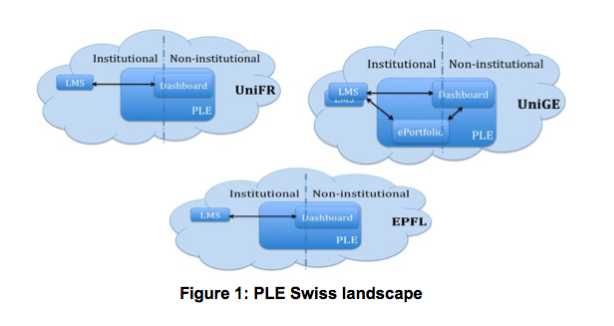Project’s objectives
The first goal of this project is to provide the students with a set of learning tools, both formal and informal. Among them, the PLE will be a key component, responsible for linking together institutional tools (eg, Moodle, Chamilo, Mediaserver, etc.) and non-institutional tools (eg, Youtube, twitter, Googledocs, etc.), as shown in Fig. 1.

The second goal is to teach how to use these technologies, that is, (1) to inform and train students and teachers about the values and educational usages of the tools proposed in the PLE and (2) to assess the tool usages so as to improve the understanding of those usages and of the users’ ICT needs.
The third goal of this project is to federate and recommend resources (tools and content) among institutions via a recommendation engine (RE). The RE :
- is designed to suggest resources according to a given context;
- is fed with both institutional and external information (resources, actions, rating, etc.), the more the RE is fed with information, the more it returns pertinent information;
- enables access to resources located outside a given institution that would otherwise remain unnoticed. This ensure that developments made for the PLE can be reused on a large scale in the Swiss academic community;
- upon request, computes a list of recommendations based on its internal information representation. This list of linked resources is then returned to the user.
Benefits
- stimulate a new learner-centric form of education;
- create learning networks where pertinent information and knowledge are shared;
- boost active and collaborative learning, critical thinking and the building of knowledge creation;
- encourage students to use web technologies beyond social networks and apply them to improve their learning;
- offer of trainings for developing Soft Skills about learning with ICTs;
- open up new perspectives in knowledge construction for teaching staff (going from course-centric Learning Management Systems (LMS) to PLEs)
Potential users: about 30’000
- Mainly students (including PhD), teachers and teaching assistants in Swiss higher education institutions (already using LMS).
- Staff working in CCSPs.

